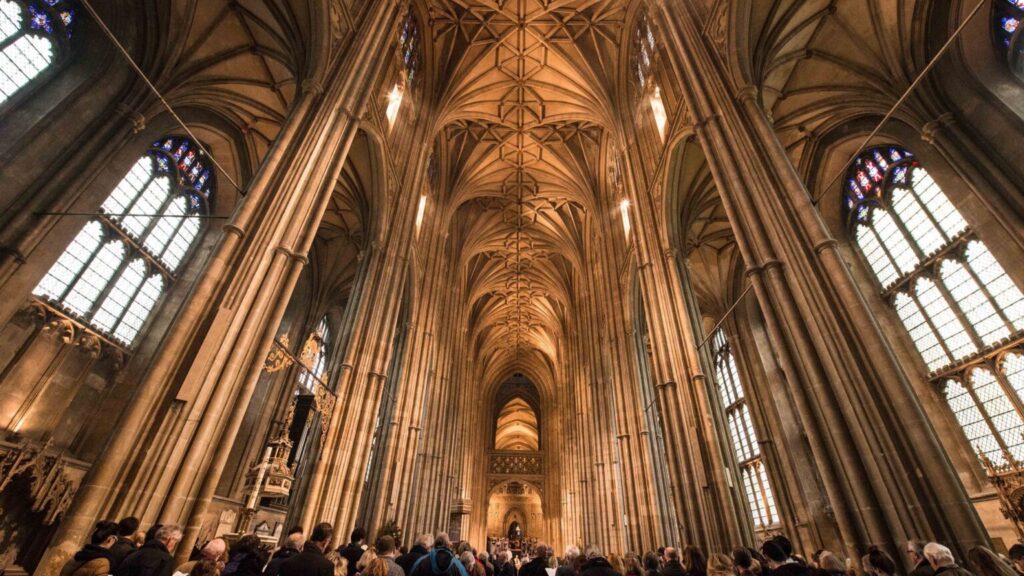
CANTERBURY, ENGLAND - DECEMBER 25: The Archbishop of Canterbury, Justin Welby, holds communion and delivers his Christmas Day sermon to the congregation at Canterbury Cathedral on December 25, 2015 in Canterbury, England. His Grace was unable to deliver his Christmas sermon last year as he was suffering with pneumonia. (Photo by Chris Ratcliffe/Getty Images)
Canterbury Cathedral, one of Britain’s most revered historical sites, has found itself at the center of a heated debate this week. The controversy erupted after the cathedral’s walls were adorned with what appeared to be graffiti, a move that has dismayed many within its traditional audience. These vivid decorations, more commonly associated with urban landscapes, were soon revealed to be temporary stickers, part of an art project titled “Hear Us.”
The project, spearheaded by the cathedral’s dean, David Monteith, aims to provide a platform for marginalized communities to express their spiritual inquiries. Despite assurances that the stickers would be removed without causing damage, the initiative has sparked a wave of criticism, particularly on social media, and has drawn condemnation from public figures such as JD Vance.
The Artistic Intent and Public Reaction
The “Hear Us” project seeks to engage visitors by posing existential questions through the medium of graffiti-like stickers. These questions, ranging from “Are You there?” to “Why did you create hate?”, aim to provoke reflection and dialogue. However, the choice of medium has been contentious, with critics arguing that it trivializes the cathedral’s sacred space.
Dean Monteith defended the project, emphasizing its temporary nature and the importance of fostering dialogue. “We wanted to create a space where people could engage with profound questions,” he stated. Yet, for many, the installation has been perceived as a jarring juxtaposition against the cathedral’s ancient stonework.
Historical Context and Cultural Implications
Canterbury Cathedral, with its 1,400-year history, has long been a symbol of stability and tradition. Its architecture has withstood the test of time, serving as a testament to the enduring nature of faith. The introduction of modern art forms into such spaces is not without precedent, but it often stirs debate about the balance between innovation and preservation.
Art historian Dr. Emily Carter noted, “The use of contemporary art in historical settings can be powerful, but it must be done with sensitivity to the site’s heritage. The challenge is to engage new audiences without alienating those who value tradition.”
The Broader Conversation on Faith and Modernity
This development follows a broader trend within religious institutions to remain relevant in an increasingly secular society. The “trendy vicar” phenomenon, where clergy adopt modern methods to connect with younger generations, has been both celebrated and criticized. It reflects a tension between maintaining doctrinal authority and embracing cultural shifts.
According to sociologist Dr. Mark Thompson, “Religious institutions are grappling with how to appeal to a diverse audience. Initiatives like ‘Hear Us’ are attempts to bridge that gap, but they often reveal underlying cultural divides.”
“In a time when we fear that many of our most cherished traditions are being traduced, it is surely with some relief that we realize that one such tradition is still alive and well – that of the trendy vicar.” – Simon Evans, columnist
Looking Forward: The Future of Heritage Sites
As the initial uproar subsides, questions remain about the future of heritage sites like Canterbury Cathedral. How can they remain culturally significant while respecting their historical significance? The debate sparked by “Hear Us” underscores the ongoing dialogue about the role of art and religion in contemporary society.
Moving forward, it will be crucial for institutions to engage stakeholders in conversations about how best to honor their past while embracing the future. As for Canterbury Cathedral, the removal of the stickers will mark the end of this particular chapter, but the discussions it has inspired are likely to continue.
In the end, the controversy serves as a reminder of the delicate balance between tradition and innovation, a balance that religious institutions must navigate as they seek to remain relevant in a rapidly changing world.







